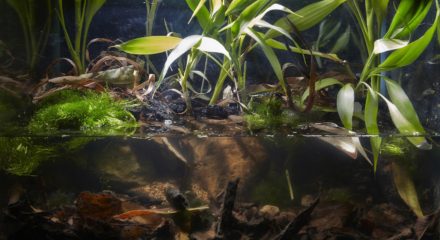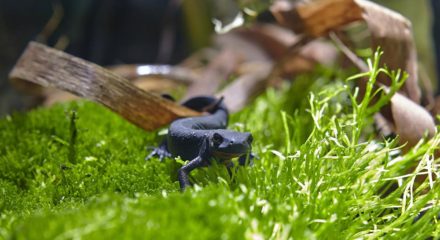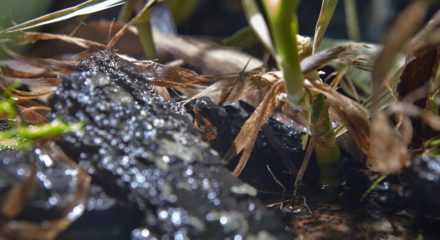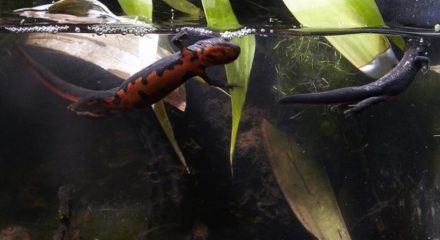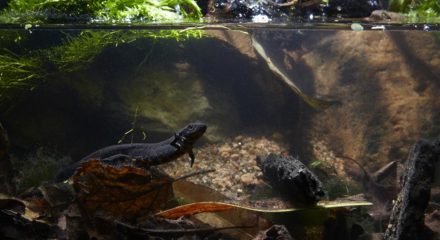Wetland backwater near the mouth of the Yangtze River in Hunan Province, China
23rd place in Biotope Aquarium Design Contest 2016
![]() Russia. Lev Ponomaryov
Russia. Lev Ponomaryov
Aquarium Volume: 35 L
Fish and invertebrates: Cynops orientalis
Plants list: Dracaena sanderiana, Ricccia fluitans, Spirogyra porticalis
Biotope description: Yangtze River, also called the Blue River, flows in China, dividing it into two parts: north and south, with temperate and subtropical climates, respectively. The river begins in the central part of the Tibetan Plateau, enters the plain, is divided into numerous channels at its mouth and empties into the East China Sea. Yangtze River flows through the sandy and clay soil, so the water in the most parts of the river is turbid, with yellowish-brown hue. During floods the river spreads widely, that’s why its water is rich in humus and has relatively high acidity, like the soil.
In my aquarium a biotope with one species of chinese newt (Cynops orientalis) is represented in autumn. Chinese newt is an endemic species of the Yangtze River. It prefers standing or slow-moving parts of the river. In the autumn it goes ashore, so its habitat is a waterlogged river bank with silted sand bottom, rocky coast, thickets of bamboo and leaves rotting in water. Neighbors in the biotope of these amphibians in nature may be members of the families Cyprinidae, Amblycipitidae, Cobitidae. But this aquarium is too small for these fishes, besides representatives of the larger species are dangerous for newts, and newts can hunt small fishes. For Cynops orientalis the size of this aquaterrarium is quite comfortable, as Chinese newt is a dwarf representative of the tailed amphibians (females are up to 7 cm, the males are even less). The newts have dark protective coloration on the top part of the body, so that even in my biotope aquarium it is not simple to find them among bark and leaves. The lower part of their body is colored brightly: it is red with some black spots, and the drawing is individual for each newt. This colouration warns that the newt is poisonous. One of the known toxins produced by the skin of the newt, a representative of the family of real salamanders, is a tetrodotoxin, considered to be the most powerful non-protein poison of natural origin and refers to neurotoxins.
Chinese newts are seasonal animals, in the autumn they come to the land and are active in the night. After winter from October to November, newts return to the water and are are active in the daytime.
When setting up my aquaterrarium I used Sander’s dracaena for imitation of a plant widespread in China: bamboo, green thread algae of the genus Spirogyra, and Riccia growing everywhere.
Fish and invertebrates: Cynops orientalis
Plants list: Dracaena sanderiana, Ricccia fluitans, Spirogyra porticalis
Biotope description: Yangtze River, also called the Blue River, flows in China, dividing it into two parts: north and south, with temperate and subtropical climates, respectively. The river begins in the central part of the Tibetan Plateau, enters the plain, is divided into numerous channels at its mouth and empties into the East China Sea. Yangtze River flows through the sandy and clay soil, so the water in the most parts of the river is turbid, with yellowish-brown hue. During floods the river spreads widely, that’s why its water is rich in humus and has relatively high acidity, like the soil.
In my aquarium a biotope with one species of chinese newt (Cynops orientalis) is represented in autumn. Chinese newt is an endemic species of the Yangtze River. It prefers standing or slow-moving parts of the river. In the autumn it goes ashore, so its habitat is a waterlogged river bank with silted sand bottom, rocky coast, thickets of bamboo and leaves rotting in water. Neighbors in the biotope of these amphibians in nature may be members of the families Cyprinidae, Amblycipitidae, Cobitidae. But this aquarium is too small for these fishes, besides representatives of the larger species are dangerous for newts, and newts can hunt small fishes. For Cynops orientalis the size of this aquaterrarium is quite comfortable, as Chinese newt is a dwarf representative of the tailed amphibians (females are up to 7 cm, the males are even less). The newts have dark protective coloration on the top part of the body, so that even in my biotope aquarium it is not simple to find them among bark and leaves. The lower part of their body is colored brightly: it is red with some black spots, and the drawing is individual for each newt. This colouration warns that the newt is poisonous. One of the known toxins produced by the skin of the newt, a representative of the family of real salamanders, is a tetrodotoxin, considered to be the most powerful non-protein poison of natural origin and refers to neurotoxins.
Chinese newts are seasonal animals, in the autumn they come to the land and are active in the night. After winter from October to November, newts return to the water and are are active in the daytime.
When setting up my aquaterrarium I used Sander’s dracaena for imitation of a plant widespread in China: bamboo, green thread algae of the genus Spirogyra, and Riccia growing everywhere.

